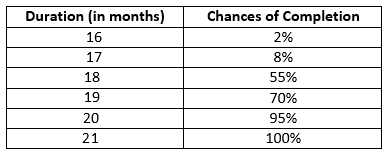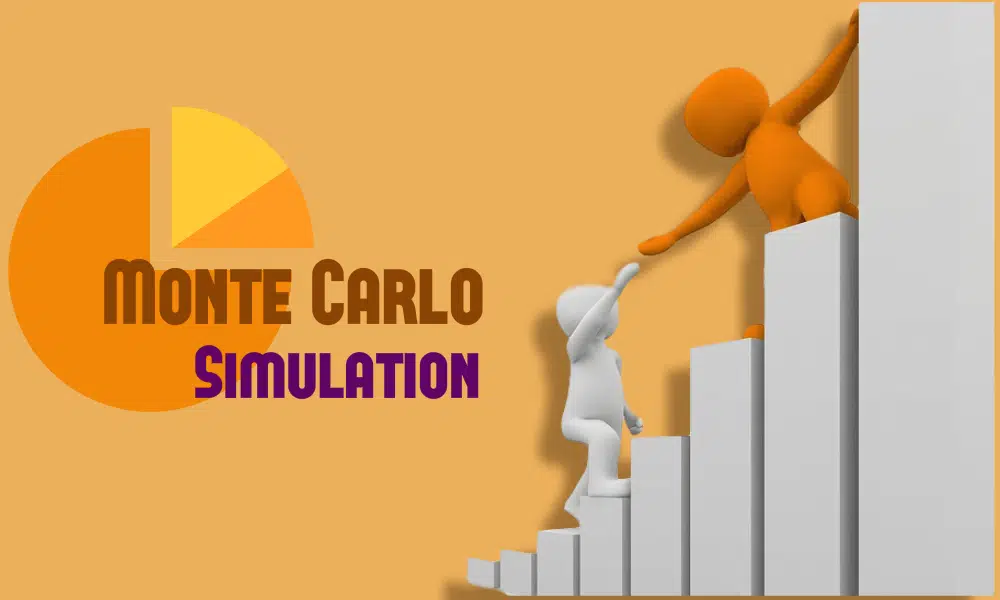A Monte Carlo analysis is a key risk management technique that many PMP and PMI-RMP exam study books gloss over.
Most guides say it is a complex technique requiring a computer’s assistance, implying that PMP aspirants do not need further detail. This assumption is not true; Monte Carlo Simulation is a straightforward technique.
Monte Carlo Analysis
A Monte Carlo analysis is a quantitative analysis technique used to identify the risk level of achieving objectives.
This technique was invented by a nuclear scientist named Stanislaw Ulam in 1940; it was named Monte Carlo after the famous casino city in Monaco.
A Monte Carlo simulation is a mathematical technique that allows you to account for risks in decision-making. It helps determine the impact of identified risks by running multiple simulations and finding a range of outcomes.
Every decision has a degree of uncertainty, and the Monte Carlo simulation helps you make decisions in such situations. It allows you to make sound choices and avoid surprises in later stages. You can run this simulation to analyze the impact of the risks on cost, schedule estimates, etc.
You get a range of possible outcomes and probabilities for any course of action.
Monte Carlo Analysis Example
Let’s discuss an example using Monte Carlo analysis when creating the project schedule. Suppose that you have three activities with the following duration estimates (in months):

According to the PERT estimate, you can complete these activities in 17.5 months.
In the best case, it will only take you 16 months, and in the worst, 21 months.
Now, if we run the Monte Carlo simulation for these tasks 500 times, it may show the following:

You can see that there is a:
- 2% chance of completing the project in 16 months
- 8% chance of completing the project in 17 months
- 55% chance of completing the project in 18 months
- 70% chance of completing the project in 19 months
- 95% chance of completing the project in 20 months
- 100% chance of completing the project in 21 months
This technique provides a more in-depth data analysis, allowing you to make a better-informed decision.
Limitations of the Monte Carlo Analysis
The Monte Carlo analysis has a few limitations, for example:
- The results depend on the quality of estimates, so if the data are biased, you will get a false result.
- The Monte Carlo analysis shows the probability of completing the tasks, not the actual time required.
- This technique is not useful for a single activity; you must have several and have risk assessments completed.
- You will need to buy an add-on or a software program to run the Monte Carlo simulation.
Benefits of the Monte Carlo Analysis
This method has many benefits in project management, such as:
- It helps you evaluate the risk of the project.
- It helps you predict the chances of failure in schedule and cost overrun.
- It converts risks into numbers for easy assessment.
- It helps you build a realistic budget and schedule.
- It helps you gain management support.
- It helps you in decision-making with objective evidence.
- It helps you to find the chances of achieving project milestones or intermediate goals.
Summary
The Monte Carlo analysis is an essential technique in risk analysis that helps you make decisions under uncertain conditions. Although it is often not used in projects, it increases the chances of achieving project success within the approved project baselines when applied.

I am Mohammad Fahad Usmani, B.E. PMP, PMI-RMP. I have been blogging on project management topics since 2011. To date, thousands of professionals have passed the PMP exam using my resources.








Thanks to brother Fahad and the reader. I have gone throgh the article and coments. Think it’s easy to conceptualize the main idea.
You are welcome Jobayer.
Hi Fahad,
You are right, most books just give a brief description and also there are no questions on this topic in most of study material I have been through. Can you please let us know what kind of questions are encountered on the PMP exam?
Regards,
Manny
You can find some free sample PMP exam questions from the following link:
https://pmstudycircle.com/pmp-questions/
Thanks Fahad. This just gave me happiness after a long search for MC. Now please, help explain the limitations of MC carefully to me, especially point 1 & 3.
A. Why always 3 estimates/assumptions? On what basis can these estimates be based—-on past knowledge, pattern knowledge or future knowledge?
B. What do you mean by simulation cannot be performed on Single activity but all activities. And then again, risk assessment must be performed on each activity? Do you mean, one must know all the activities that must be carried out to complete a task, the run MC simulation(risk analysis) on each of these activities? Why can’t MC be run on all these activities together at once so one can have a more holistic result that would show the effect of interconnectedness?
C. Can MC be used also for operational (day to day) decisions as it seems it’s good for only strategic decisions?
Thanks a lot for quick response. I would be very grateful.
A) PERT technique reduces the biases so we use it.
B) This is not a tool to use for every single activity.
C) We mainly use it for finalizing budget and schedule for a project
it is my understanding that in the PMP exam we will not have access to simulation software. is there a manual method for exam purposes?
You can go for paper based exam.
Thanks for putting this in the most simplest form to understanding the technique..
You are welcome Anu.
hello dear
I have a question how do we know that 16 =2% is there a method or equation help us to find it correctly
thanx
In this blog post, this is an assumed data. You will get the real data when you enter correct data in Monte Carlo simulation software.
If you are asking about how the Monte Carlo Method is working
It is working by generating random (according to predefined probabilities) samples then calculating the overall probability
For example assume that you have a board and a circle drawn on that board
Let’s throw darts and see how many fell inside or outside the circle
We can calculate the circle area by multiplying the % of darts fell inside by the total area of the board
Hi Fahad,
I have a small concern, what would be the inputs that are mandate to run this tool. For example Calculating the schedule we would need all the activity with there estimates, risk assessment done for all the activities and what else that is required.
Please help me on this
You will need to enter the estimated duration for activities, such as most likely, pessimist and optimistic.
How Monte Carlo Simulation help to find out Risk level? Please give examples
The example is given in the blog post.
Good article and expecting Latin Hypercube sampling also
I have noted your suggestion and I will try to write a post on this topic in future.
Simple and well explained. Has anyone heard of MC being used in construction projects ?
It is used on all types of projects.
Thank you so much Fahad! Very helpful! I have my exam scheduled on Sept 9th and i am going through all the anxiety to clear this exam
Thanks Lcm for your comment.
Very good and simple explanation.
Thanks Fahad !!
I am glad you liked it Ar. Thanks for your visit.
I like it. Thank you so much Fahad
Maysara
You are welcome Maysara.
Very simplified to understand. Thanks for the article….
You are welcome Ty.
Nice article…
The way of explanation is very good…
Thanks Professor.
Good article!
Thanks Mike for you visiting and leaving your comment.
Assalam o Aleikum, Brother,
In above example, Activity A will have pert estimate equal to 5 instead of 4.3.
{4+(4×5)+6}/6 = 5
Thank you for sharing . It was very informative.
The table is corrected.
Dear Fahad sb,
Assalam o Aleikum,
First of all, Jazak Allah Khair for writing this important blog post explaining technique used in quantitative risk analysis process.
1) In this blog post, I’m not understanding that how does Monte Carlo Simulation actually works and calculate chances of completion (%ages) ?
2) Any mathematical calculation or example or formula ?
Also, which software is required to run this simulation ?
WaSalaam,
You only come up with your estimates, and input these information into the program. The program will do the calculation for you.
There are many Monte Carlo simulation software available on the net. Just search it on Google and you will get many.
Resourceful Fahad. Appreciated
Thank you Sufian.